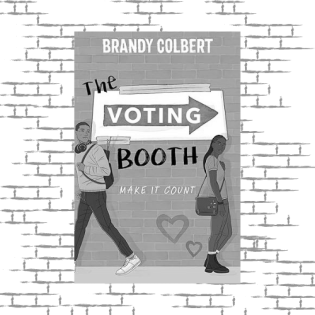The Voting Booth Literature Guide
Keywords:
Democracy
Social Action
Social Justice
Voting
by Brandi Colbert - This book tells the story of two first-time voters overcoming barriers to vote on Election Day. The guide below provides discussion questions and activities to spark conversation about voting rights, voter suppression, and personal action.
The Voting Booth is an exciting one-day story of two African American teens making a difference at the voting booth. Marva is a life-long activist voting for the first time who sees Duke being turned away. Together they overcome barriers for Duke and others in the community. This fun and romantic story illustrates why and how young people can each take action with their voices and get support from the multi-generational community around them. They show us that you can't sit around waiting for the world to change.
Discussion Questions
- What do you know about Marva's outlook on voting from the first chapter?
- Duke's attitude about voting is less certain than Marva's, so what factors bring him to the voting booth so early in the morning?
- In the first chapter, Marva says, "I hate it when adults do that - act like what we're going through isn't serious just because we're younger than them." What does that mean to you?
- What are some barriers that Duke, Clive, and others face as they try to vote?
- Some barriers affect some people more than others. How does this make the barriers harder to overcome?
- How would you compare Marva's relationship with Alec to her relationship with Duke?
- What evidence supports the idea that avoidance of tough topics makes communication between friends and family more strained?
- What do you notice about Marva and Duke's relationships with their families? What different family structures are represented?
- What racial issues come up in families and relationships? How are they discussed or ignored?
- What would you do in the situation when Marva is pulled over?
- Compare the two stories of being pulled over by the police. What details did the author use to make you feel the stress of the situation?
- What are some examples of a multi-generational community working together?
- What issues that come up in the book - racism, voter suppression, civil rights, guns, abortion, immigration, healthcare - also come up in conversations with your friends or family? What issues compel you to vote or speak up?
Activities
- Marva is aware of voter suppression and knows what to do when Duke can't vote. Look up the voter requirements and rights in your state and community. Share what you learn to raise awareness and promote voter turnout.
- Marva uses her Eartha Kitty social media to promote her passion for voting. Design some posts for your social media or posts you would suggest to promote civic engagement.
- Look up ways to take action safely, using your voice, protest, advocacy, and organization skills. What fits your style and skills? How can you stay safe?
- Organize a plan for friends and family to help voters get to the polls in your community where help is needed. Do some research about what polls are busy and organize snacks, activities for children, and other ways to make the time run smoothly for voters.
Reflection
- What are your thoughts about participating in the activities?
- What have you learned that you didn't know before about the history of voting, especially related to people of color?
- What are your thoughts about voting issues in today's elections?
